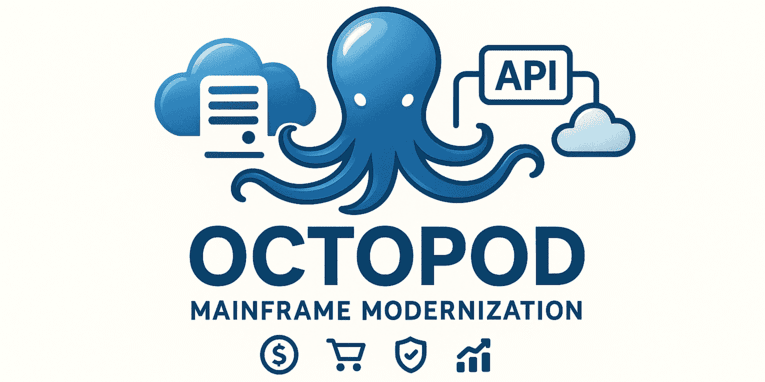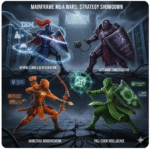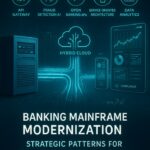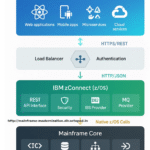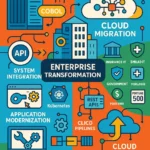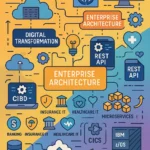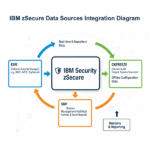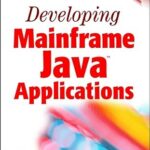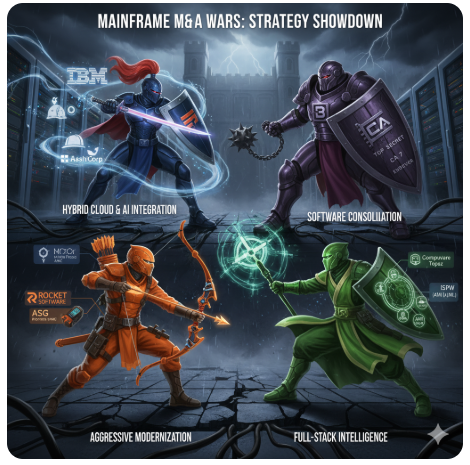Most mainframe modernization projects don’t fail because of technology. They fail because organizations underestimate these four critical mainframe transformation challenges. The mainframe modernization market is hitting $13.34 billion by 2030, but here’s what vendor pitches won’t tell you: these mainframe migration challenges are what separate successful legacy system transformation from expensive failures.
Challenge #1: The Mainframe Documentation Black Hole
Thirty years of accumulated mainframe code. Legacy system documentation? What documentation? The mainframe developers who wrote that COBOL code retired in 2003, taking their mainframe knowledge with them.
This mainframe modernization challenge isn’t just inconvenient—it’s foundational. You can’t modernize legacy systems you don’t understand. You can’t execute mainframe migration without knowing dependencies. You can’t build a mainframe transformation business case without understanding what each mainframe application actually does.
The mainframe documentation reality: Most organizations discover during mainframe assessment that thousands of COBOL programs have zero current documentation. Comments in legacy code? Maybe, probably wrong. Design documents showing mainframe architecture? Lost during some office move twenty years ago.
Mainframe Code Analysis Solution: AI-Powered Tools
What changed the mainframe modernization game: AI-powered mainframe code analysis tools. IBM Watson Code Assistant for mainframe modernization, Google’s Mainframe Assessment Tool (MAT), AWS BluAge—these mainframe assessment technologies use AI to reverse-engineer legacy applications and generate mainframe documentation automatically.
How AI mainframe analysis works: These mainframe modernization tools scan entire legacy codebases—COBOL, PL/I, Assembler, JCL—and use AI trained on millions of lines of mainframe code to understand what your legacy applications do. They identify mainframe business logic, map legacy system dependencies, document data flows.
Mainframe code analysis that took consultants six months gets done in weeks through AI-powered mainframe assessment. Not perfect mainframe documentation, but good enough for mainframe modernization decisions.
Real mainframe assessment results: Companies using AI mainframe analysis report 70-80% faster mainframe documentation generation. More importantly, they discover critical mainframe dependencies that prevent costly mainframe migration failures.
Financial services company used Google MAT for mainframe assessment and discovered their “simple” customer application had hidden dependencies on 47 other mainframe programs. Without AI-powered mainframe analysis, they would have started mainframe migration and broken half their business processes.
Challenge #2: The Mainframe Skills Gap Crisis
Your best mainframe developers are retirement age. Many already retired from mainframe careers. Nobody’s learning COBOL programming in college anymore—that’s the mainframe skills gap threatening enterprise mainframe operations.
This mainframe talent shortage creates perfect storm for mainframe modernization. You need mainframe expertise to understand legacy applications. You need cloud skills to build modern infrastructure. You need people understanding both mainframe technology and modern architecture. These mainframe modernization unicorns don’t exist in quantity.
Mainframe skills shortage numbers: 60% of organizations report difficulty finding qualified mainframe professionals. COBOL programmers declining 5% annually as retirements accelerate. Computer science programs teaching mainframe skills dropped 90% since 2000. The mainframe talent crisis is getting worse, not better.
Mainframe Skills Solution: Training, Tools, and Hybrid Architecture
What works for mainframe talent shortage: combining mainframe training programs, AI-powered COBOL migration tools, and hybrid mainframe architecture that naturally manages mainframe skills transition.
Mainframe training programs: IBM Z Xplore mainframe learning platform, Broadcom’s mainframe academy training next-generation mainframe professionals. These aren’t old mainframe courses—they teach modern mainframe development, cloud integration, DevOps for mainframe environments.
AI-powered COBOL migration: AWS BluAge, IBM Watson Code Assistant translate COBOL to Java or Python automatically through automated code conversion. These mainframe modernization tools augment mainframe skills by automating mechanical mainframe code translation.
Manufacturing company used IBM Watson for COBOL migration, reduced mainframe conversion from projected 36 months to 18 months. AI handled routine mainframe code while limited mainframe experts focused on complex mainframe business logic.
Hybrid mainframe modernization: Here’s the elegant mainframe skills solution: hybrid mainframe architecture naturally manages talent transition. Senior mainframe experts focus on core mainframe processing requiring deep mainframe expertise. Younger developers with cloud skills work on cloud-native components. Mainframe knowledge transfers through integration points in hybrid mainframe architecture.
Challenge #3: Mainframe Data Migration Nightmare
Moving decades of VSAM files and IMS hierarchical databases to modern data platforms without corrupting customer records? That’s the mainframe data migration nightmare keeping CTOs awake during mainframe transformation projects.
This mainframe modernization challenge isn’t theoretical. One corrupted customer record during mainframe data migration cascades into millions in losses and regulatory investigations. The mainframe data complexity—accumulated data formats, undocumented data relationships, decades of data transformation rules—makes legacy data migration the highest-risk mainframe modernization phase.
Mainframe data migration risks: Legacy data formats don’t map cleanly to modern databases. VSAM files require special handling. IMS hierarchical structures need restructuring for relational or NoSQL databases. Mainframe data quality issues hidden for years surface during migration.
Mainframe Data Migration Solution: CDC and Operational Data Layers
What works for mainframe data challenges: Change Data Capture (CDC) technology for real-time mainframe data replication combined with operational data layer architectures.
CDC for mainframe data: Companies like Precisely built mainframe data integration tools specifically for mainframe data migration challenges. CDC technology enables real-time mainframe data replication to modern platforms while mainframe systems continue operating. You’re not doing big bang mainframe data migration hoping everything works.
Operational data layer approach: Hybrid mainframe modernization shines in mainframe data migration. Build operational data layers syncing with mainframe databases in real-time. You’re validating mainframe data accuracy continuously during migration. Applications gradually shift to modern data platforms while mainframe remains system of record until confidence is established.
Wells Fargo mainframe data approach: Built operational data store (ODS) using MongoDB handling 20 terabytes of mainframe data daily. Real-time synchronization with mainframe systems. Validates data accuracy continuously. Zero mainframe disruption during data modernization.
This mainframe data strategy reduces mainframe migration risk dramatically. You’re not betting the business on one-time mainframe data conversion. You’re incrementally validating mainframe data migration accuracy before fully cutting over.
Challenge #4: Mainframe Modernization Cost Uncertainty
Every CIO has pitched mainframe modernization knowing real mainframe transformation costs will exceed estimates. Every CFO knows mainframe modernization budget reality too. This mainframe cost uncertainty kills projects before they start.
Mainframe modernization cost problem: Estimating mainframe transformation expenses is notoriously difficult. Unforeseen mainframe migration issues emerge. Hidden mainframe dependencies surface. Mainframe complexity balloons. Timelines stretch. Mainframe modernization budgets overflow.
Mainframe Cost Solution: Phased Approach with Quick Wins
Mainframe modernization cost reality: Kyndryl mainframe research shows mainframe modernization projects typically consume 3.9% of IT budget. But—critical for mainframe modernization business case—they generate average annual mainframe cost savings of $23.3 million. Companies become 9-11% more profitable through successful mainframe modernization.
Mainframe cost management trick: Phase mainframe transformation demonstrating mainframe cost reduction before requesting additional mainframe modernization funding. Quick mainframe migration wins buy credibility for harder mainframe modernization phases.
Phased mainframe modernization approach:
- Phase 1: Mainframe rehosting for immediate MIPS reduction. Quick mainframe cost savings (6-12 months)
- Phase 2: Mainframe data offloading to operational data layers. Measurable mainframe performance improvement
- Phase 3: Mainframe application refactoring for critical customer-facing systems
- Phase 4: Complete mainframe transformation for non-critical applications
Each mainframe modernization phase delivers measurable results—cost reductions, performance improvements, new capabilities. You’re building mainframe transformation momentum and proving mainframe modernization ROI before major investment.
Budget for mainframe modernization contingency: Industry best practice allocates 20-30% contingency for mainframe transformation projects. Mainframe modernization complexity always exceeds initial estimates. Smart organizations plan for mainframe cost uncertainty upfront.
Mainframe Modernization Challenges: The Bottom Line
These four mainframe modernization challenges—legacy documentation gaps, mainframe skills shortage, data migration complexity, and cost uncertainty—determine mainframe transformation success or failure. The good news? Solutions exist for every mainframe modernization challenge.
AI-powered mainframe assessment tools solve documentation challenges faster and cheaper than traditional mainframe analysis. Hybrid mainframe modernization architectures naturally address skills gaps while managing risk. CDC technology and operational data layers make mainframe data migration manageable. Phased mainframe transformation approaches control costs while demonstrating measurable mainframe modernization ROI.
Companies succeeding at mainframe modernization don’t ignore these legacy system challenges. They address them strategically using proven mainframe transformation tools and methodologies. They build mainframe modernization plans anticipating these challenges rather than discovering them six months into failed mainframe migration.
Your mainframe modernization journey will face these four challenges. The question isn’t whether you’ll encounter legacy system obstacles. The question is whether you’ll proactively solve mainframe transformation challenges using proven approaches—or learn expensive lessons the hard way.
The mainframe modernization market is growing to $13.34 billion by 2030 because organizations finally have mature tools addressing these critical legacy system challenges. The companies winning mainframe transformation acknowledge these mainframe modernization obstacles upfront and deploy appropriate solutions from day one.
Start your mainframe modernization journey by honestly assessing these four challenges in your environment. Which legacy documentation gaps exist? What’s your mainframe skills situation? How complex is your mainframe data migration? What’s realistic for mainframe modernization budget and timeline?
Answer these mainframe transformation questions accurately, and you’re halfway to mainframe modernization success. Ignore these legacy system challenges, and you’re setting up another failed mainframe migration project.
The choice is yours. The tools exist. The solutions work. The question is whether you’ll face mainframe modernization challenges strategically—or become another cautionary tale about mainframe transformation gone wrong.
Related Mainframe Modernization Resources
Mainframe Modernization Market Research: Markets and Markets. (2025). “Mainframe Modernization Market Size: Trends & Industry Forecast [2030].” https://www.marketsandmarkets.com/Market-Reports/mainframe-modernization-market-52477.html
Mainframe Assessment Tools:
- IBM Watson Code Assistant for Mainframe Modernization
- Google Cloud Mainframe Assessment Tool (MAT)
- AWS BluAge for COBOL Migration
Mainframe Modernization Cost Analysis: Kyndryl Research (2024). “Mainframe Modernization ROI and Cost Benchmarks.” Referenced in EPAM Insights (2025) on Mainframe Transformation Economics.
Wells Fargo Mainframe Data Modernization Case Study: MongoDB. (2025). “Wells Fargo Launches Next Generation Card Payments.” https://www.mongodb.com/customers/wells-fargo
